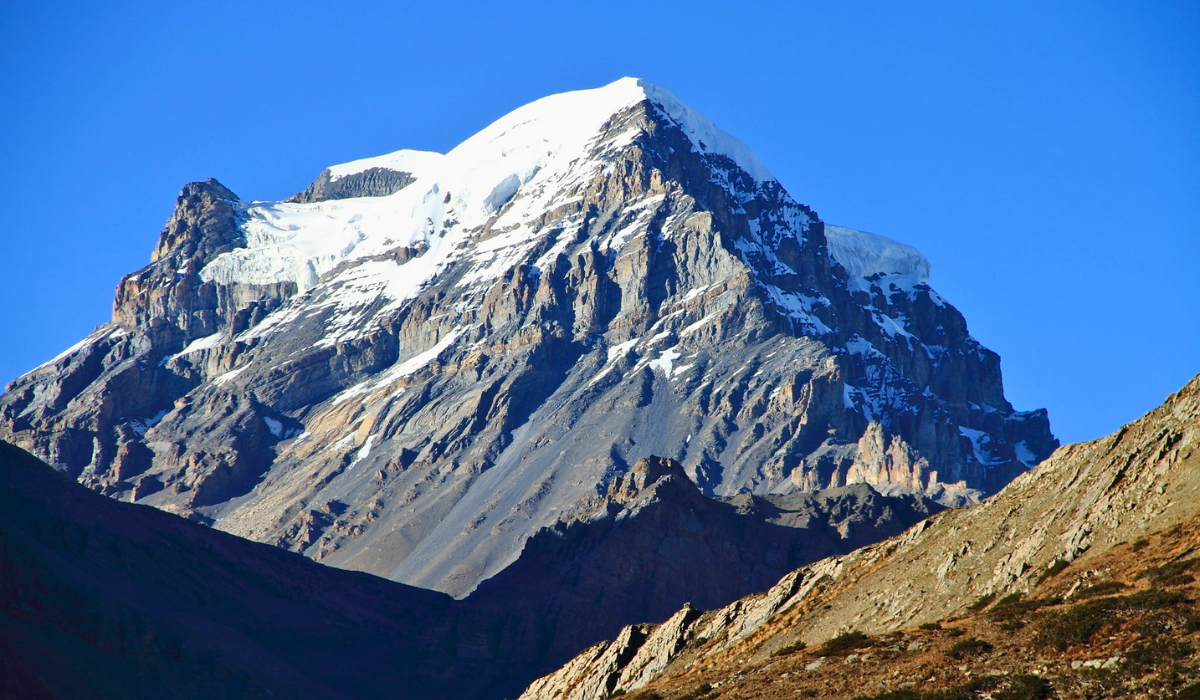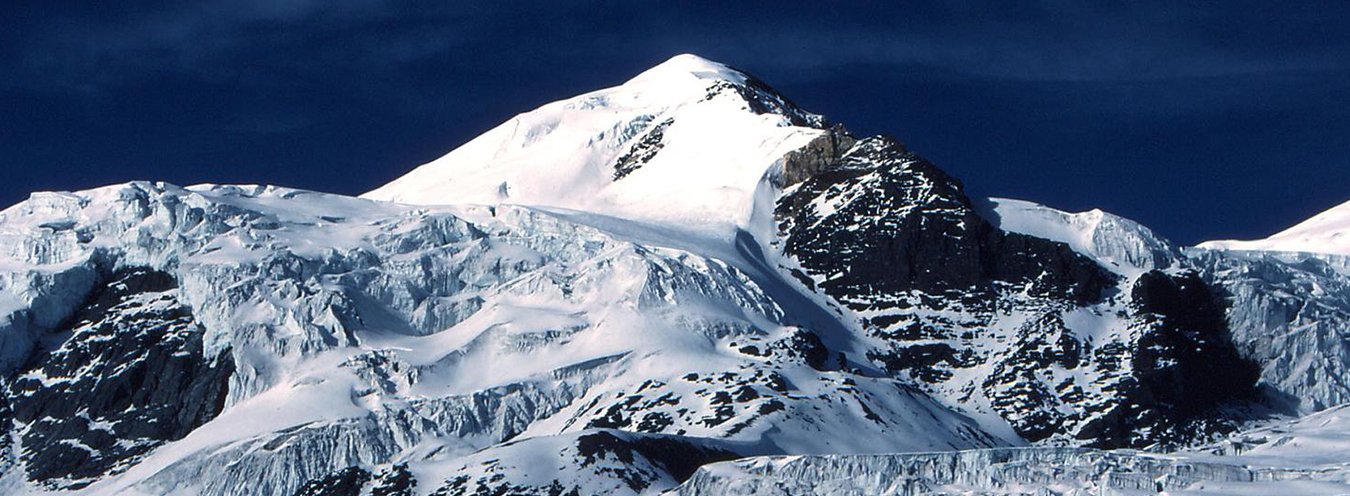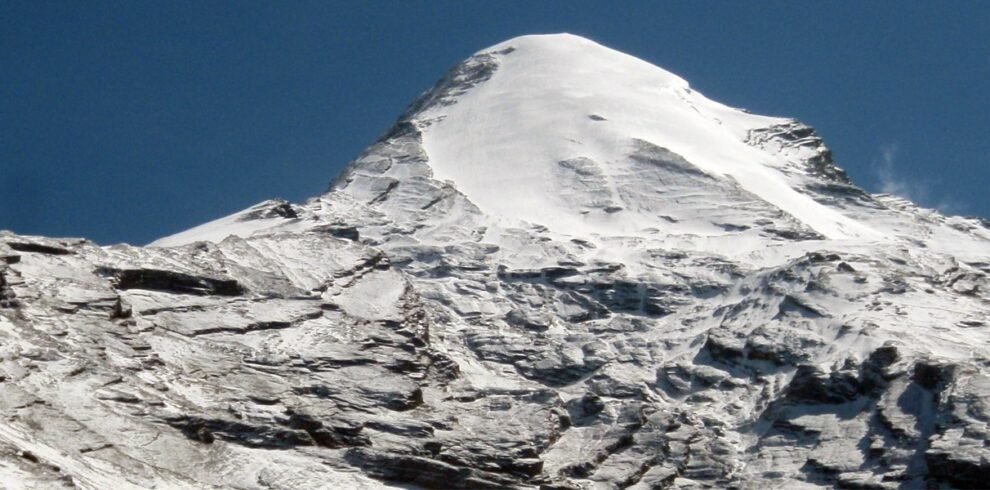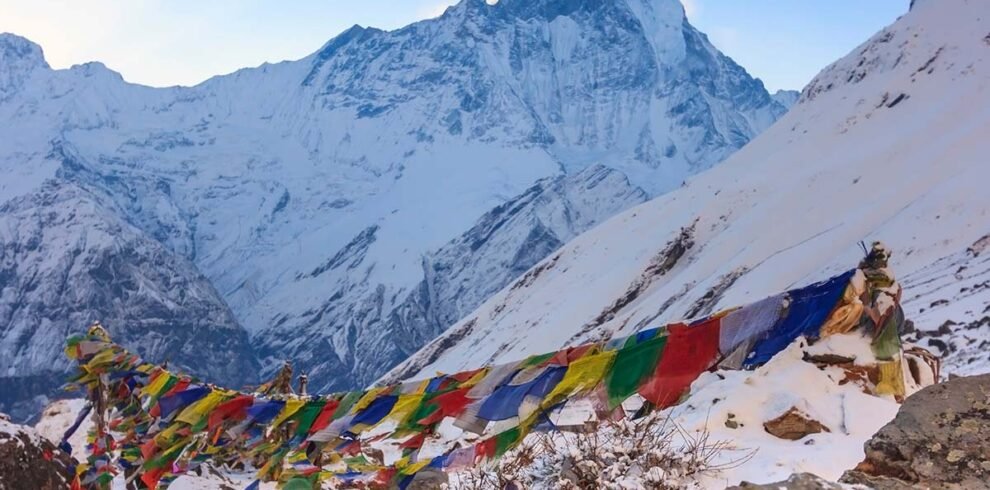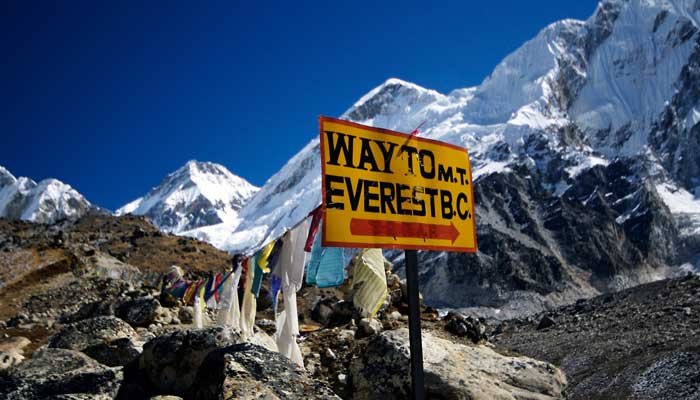Chulu West Peak Climbing (6,584m) is a challenging and rewarding adventure in the Annapurna region, high above the Manang Valley. Known for its technical difficulty, the climb requires prior experience with mountaineering gear like crampons, harnesses, ice axes, and rope techniques, especially for glacier crossings.
From the summit, climbers are rewarded with breathtaking views of Annapurna I, III, IV, Dhaulagiri, Manaslu, Tilicho Peak, Gangapurna, and the Glacier Dome. The Chulu massif includes both Chulu East and West peaks, often causing confusion due to unclear mapping and multiple visible summits in the same area.
Chulu West is commonly combined with the classic Annapurna Circuit Trek, offering one of the most scenic and adventurous experiences in the Himalayas. This climb is best suited for experienced trekkers seeking a serious alpine challenge.
Trip Info
-
Hotel/Lodge/Tea House during the trek
-
Spring/Autumn/Winter
-
6584m
-
Fly/Car/Jeep/ Bus
-
5/6 hours
Overview
Chulu East Peak Climbing (6584m) is one of the most beautiful peaks located in the whole of the Himalayas. This beautiful peak lies in the Annapurna Mountain Range. Chulu East Peak Climbing is also part of the Damodar Himal. This peak is graded as a less technical peak. If you are thinking of this mountaineering adventure, we recommend you have some mountaineering experience. The knowledge about the use of mountaineering gear and equipment such as crampons, harnesses, ice ax, tying knots, handling climbing ropes, etc. is a must for this adventure.
Trip Highlights
- Chulu East Peak is one of the highly-rated trekking peaks in Nepal.
- Chulu East Peak is the straightforward trekking peak in the Annapurna region.
- Explore the beautiful Gurung Villages in Annapurna Region.
- Chulu East Peak Climbing trip is a combined trekking experience with the most popular Annapurna Circuit Trekking
- Chulu East Peak Summit climbers enjoy the panoramic views of the Annapurna, Dhaulagiri and Manaslu Himalayan ranges.
Itinerary
Upon arrival at Tribhuvan International Airport in Kathmandu, you’ll be warmly welcomed by our team and transferred to your hotel. After check-in, you can rest or explore the nearby streets of Thamel. In the evening, there will be a short briefing about the Chulu West Peak Climbing itinerary and necessary preparations. Overnight stay at a hotel in Kathmandu.
Today you'll explore the cultural highlights of Kathmandu with a guided sightseeing tour. Visit UNESCO World Heritage Sites such as Pashupatinath Temple, Boudhanath Stupa, and Swayambhunath (Monkey Temple). After sightseeing, you'll have time to check your gear and prepare for the trek. Your guide will conduct a detailed briefing and ensure all climbing permits and logistics are ready. Overnight stay at your hotel in Kathmandu.
After breakfast, begin your journey with a scenic drive from Kathmandu toward the Annapurna region. You'll pass through beautiful landscapes, river valleys, and traditional villages. Depending on road conditions, you’ll either stop at Khudi or continue further to Syange. This marks the starting point of your trek. Overnight stay at a guesthouse.
Upon our breakfast, we start our journey today in a relaxed way. We enter Manang district after crossing a large bridge near Tal. The trail continues through barley, rice, potato fields, and pine forests. After passing the village of Kodo we will be at Dharapani, one of the big villages in the Manang valley. Overnight at Dharapani.
Today, we negotiate a few steep forested ridges along with several landslides on the route on the west. On the way to Chame, we encounter with the most sensational views of Lamjung Himal, Annapurna II, and Annapurna IV (7,525m). Small hot springs add relief on our long day hard trek. Chame is the administrative center of the Manang District.
There are two routes that we can follow today. If taken upper route (Nepal Everest Base Camp Treks recommends), i.e., the route through Upper Pisang via Geru, the sceneries will be outstanding. We feel like we are horizontally in front of the majestic peaks. The panoramic views of the mountain peaks, such as Annapurna, Pisang peak, and several others will definitely allure us. We notice a contrast with the landscape and vegetation from today onwards. The cold and dry climate creates a much harsher environment. We pay our memorable visit to Barge monastery, the largest in the entire district of Manang. Overnight in Manang.
Today is the scheduled acclimatization day. It is not recommended to stay idle but a short walk to higher altitude will be better to get acclimatized with the altitude. Manang is a good place to do that as the next two days will be a very challenging and tiring trek for us with the rapid gain in altitude. We should never be confident with the altitude and always be cautious. Bhojo Gompa or Gangapurna Lake is worth visiting sites from the acclimatization point of view. We make an easy excursion to a little distance away to a village called Varga, a small old village with a monastery. At this juncture, we also make our short visit to the Himalayan Rescue Association where we can get some ideas about Mountain Sickness. Overnight at Manang.
From Manang, we continue through alpine landscapes with high altitude vegetation and forests. A gradual ascent takes us to Yak Kharka and then to our today’s camp. Our today’s camp area is mostly used as the alpine pasture by the local people.
Today, we continue our trekking from Leder to Chulu West Base Camp. From the Base Camp, we can enjoy the views of Annapurna Himalayas. We may also like to discover the surrounding areas. At this point, we will set up our camp for an overnight stay.
From the Chulu Base Camp, we continue hiking towards Camp I. The route is not that technical. But it would be better to remember that we are climbing at high altitudes. At this juncture, we relish the magnificent views of Annapurna II and Dhaulagiri mountains, including Manaslu, Gangapurna, and Lamjung Himal.
Today is a scheduled rest and acclimatization day at Base Camp to help your body adjust to the high altitude before the summit push. You can take short hikes around the area, review climbing techniques with your guide, and check your gear. Rest well and hydrate to prepare for the upcoming ascent. Overnight stay in a tented camp at Base Camp
Today, we leave camp I and continue climbing the rock band to Camp II. The route is not that technical but we may have to use ropes, crampon, and ice-ax. We set up Camp II at 5,530m. Some visitors also attempt the summit directly from Camp I. However, since the climb is relatively straightforward from the Camp II until the summit, we make an overnight stay at Camp II for proper rest and acclimatization.
It is our summit day, and it is going to be a long day. Therefore, we would wake up much earlier today. Each moment we have to work hard through the icy high-altitude trail but the outstanding high Himalayan scenes are such tempting that our eyes love to watch more over the horizon than on our trail. After the summit, we return back to Camp I.
Today, you’ll ascend from Camp I to Lader, navigating steep terrain and using technical climbing skills. This section requires focus and endurance as you gain altitude and approach higher camps. Enjoy stunning mountain views along the way. Overnight stay at Lader camp in tents.
After the successful ascent of the Chulu West Peak, we shall now head for the base of challenging Thorong La Pass. Retracing back the trail leading to the base camp we go back the same trail till Ledder and then trek in the northern direction towards the challenging pass. During the trek towards the pass, you get to cross several small streams flown out of the Chulu East and Chulu West peaks and trek past some landslide-prone areas besides some sparsely located tea shops. After the trek of around 6 hours, you shall reach the base of the pass known as Thorung Phedi. Depending upon the fitness level, interest, and other circumstances trekking guide may decide to trek higher up to the High Camp. Stay overnight in Thorung Phedi or High Camp.
Today we shall have another challenging day of our trekking beside the summit of Chulu West Peak a few days earlier. Starting from the Thorung Phedi, the first section of the trail is very steep as the trek from base camp to high camp ascents to a higher altitude in a quick fashion. The trail then eases out as we approach the top. Though the trail eases out after an initial steep phase, the higher altitude still makes it difficult for the trekkers. After trekking for about 4 hours and crossing numerous false summits, trekkers reach the top of the Thorung La Pass (5,416m/17,769ft.). The sight from Thorung La Pass, arguably the largest pass in the world, is marvelous. Trekkers get to witness the view of majestic peaks of the Annapurna range, the beautiful valleys, and gorge formed by the torrential Kali Gandaki River, and the snow-capped peaks to the far in Tibet. After spending some time at the summit of the pass you shall then descend from the pass, slowly and gradually. Though the trail from the pass is gentle at the beginning, it turns out to be steep and winding in several sections until it reaches the grassy slopes at the foothills of the challenging pass. Ahead of the foothills of the pass, the trail leads us to the settlement of Chaharu past the ruins of Yak Herder’s nest, and then to the holy pilgrimage of Muktinath. Stay overnight in Muktinath.
Get amused at the beauty of the region and the exemplary religious harmony displayed at the Muktinath Temple, the temple of Hindu God whose name means “God of Salvation” in Hindu and “Nirvana” in Buddhism. Prayers are made to the god by both the Hindus and the Buddhists; there are temples and gompas in the surrounding areas of the temple and the heritages are dedicated to Hindu and Buddhist deities. The flame ignited due to geothermal heat and the 108 holy taps believed to wash the sins of pilgrims are the other attractions of this sacred destination. We trek ahead of this holy destination, where the pilgrims flock from India as well, and move to another scenic settlement of Kagbeni. The trail ahead starts just ahead of Muktinath Temple and proceeds in a twisting trail through small settlements, several Chortens, and prayer wheels to reach Dzong and further ahead to Putak. Ahead of Putak, you shall walk through the barren landscape and beautiful views of the mountains. As you cross the highest point before descending to Kagbeni the atmosphere gets windy. You reach scenic Kagebeni after you have a short steep descent down a gully. Stay overnight in Kagbeni.
After trekking in the arid and windy landscape of Kagbeni, today you shall follow the trails of Kali Gandaki River as you are heading for Jomsom. Situated at the Kali Gandaki valley, Kagbeni was once one of the major trade routes between Tibet and India and the fortified arrangement of houses shows the importance of this place in the past heydays. We start early from Kagbeni so as to avoid the strong and dusty wind blowing up the valley in the section between Kagbeni and Kalopani. The trail continues along the Kali Gandaki River and traverses through the ruins of the village, and several lively settlements including Ekle Bhatti. The trail from Ekle Bhatti to Jomsom is an easy trail that takes trekkers through sand beaches formed by the river, some ancient gompas, and other such heritages and along the road that takes people and goods to and from Jomsom to upper areas including Muktinath. Stay overnight in Jomsom, a scenic village that hosts important offices including the ACAP office and Army Mountaineering, some temples, Mustang Museum, hospital, and other establishments.
The adventure in the enchanting Annapurna region and the once restricted areas of Manang and Mustang, we shall leave for Pokhara. This marks the end of our adventurous trekking. The flight to Pokhara from Jomsom starts early in the day as in the afternoon the weather creates disturbances for the flight to take place. Flying above the contrasting landscapes, above the deepest gorge and the lush valley created by Kali Gandaki River, with the view of glittering mountains including the Annapurna massifs we reach the scenic city and the unofficial tourist capital of Nepal, Pokhara city. After relaxing we shall move in for the excursion around the Pokhara valley. This Lake City has a lot to offer tourists. From the famous Phewa Lake (on clear weather days we can see the reflection of Fishtail Mountain on the lake) to the shy Devis Falls, from the Mahendra Cave named after the former king of the Shah dynasty to the Gupteshwor Mahadev cave with the shrine of Lord Shiva you have many sites to explore. The International Mountaineering Museum provides information on the Himalayas, mountaineering, and the culture of the inhabitants around the valley. After exploring the diverse nature sites, get back to the hotel for your stay. Overnight stay in Pokhara.
Today upon our breakfast, we make a 200 kilometers drive back to Kathmandu from Pokhara. It will be better to hold on the left pane of the vehicle to enjoy the scenery through the route. Upon arrival in Kathmandu, we will be escorted to our hotel. There is nothing to do but trade emails with travel companions and organize the photos. We can spend the evening either leisurely or perhaps catch up on some last-minute shopping. Finally, we celebrate dinner together with the Brotherhood Adventure Team.
Our journey in Nepal comes to an end today. Brotherhood Adventure will escort us to the airport for our flight. Approximately 3 hours before our scheduled flight, a representative from Everest Alpine Trekking will escort us to the airport and bid farewell. On our way home, we will have plenty of time to plan our next adventure in a wonderful country like Nepal.
Includes/Excludes
Includes
- Airport pickup and drop-off in Kathmandu
- Teahouse/lodge accommodation during the trek
- Tented camping during climbing days with necessary gear
- All meals during trek and climbing (breakfast, lunch, dinner)
- Experienced, licensed English-speaking trekking and climbing guides
- Climbing permits (Chulu West Peak permit, Annapurna Conservation Area Permit, TIMS)
- Government taxes and official service charges
Excludes
- International airfare and Nepal visa fees
- Personal travel and climbing insurance (must cover high-altitude trekking and emergency evacuation)
- Personal climbing gear (boots, gloves, down jackets, headlamps, etc.)
- Meals in Kathmandu not included in itinerary
- Tips for guides, porters, and staff (optional but appreciated)
- Extra accommodation or transportation due to itinerary changes, weather, or delays
FAQs
Chulu East Peak Climbing is situated in the Manang district of Nepal, in the Annapurna region. It is part of the Chulu Massif, which includes Chulu West and Chulu Central peaks.
Chulu East Peak Climbing stands at an elevation of 6585 meters,above sea level.
Yes, you need to obtain the Chulu East Peak Climbing Permit, which can be obtained in Besisahar or Chame. Additionally, you will also need the Annapurna Conservation Area Permit (ACAP).

